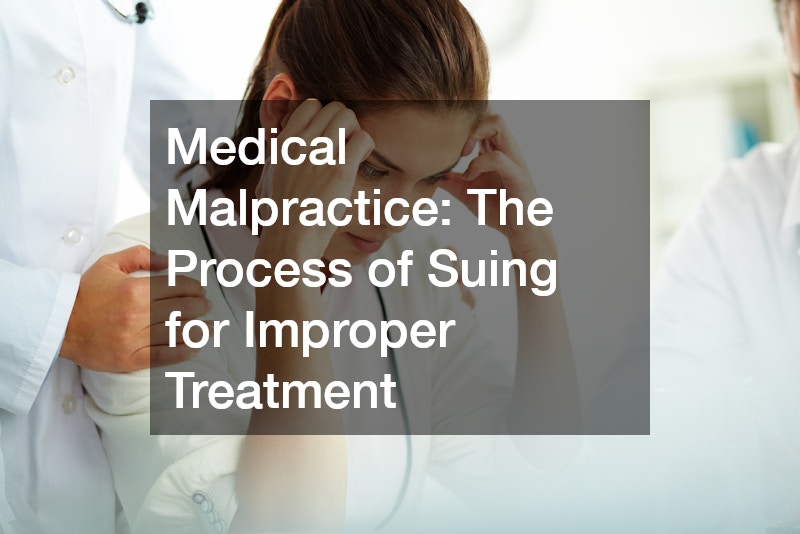
Medical malpractice is a serious issue that affects countless patients every year. It occurs when a healthcare professional fails to provide the standard of care, resulting in harm to the patient. This article aims to explore the process of suing for improper treatment, highlighting the complexities involved, from understanding the basis of a malpractice claim to the steps necessary to pursue legal action. Along the way, we will also touch on various related healthcare topics, such as cosmetic procedures, emergency clinics, and clinical research participants, to provide a comprehensive overview.
Understanding Medical Malpractice
Medical malpractice claims often arise when patients experience negative outcomes due to the negligence of healthcare providers. The standard of care is defined as the level of care that a reasonably competent provider would have provided under similar circumstances. When this standard is breached, and the patient suffers as a result, it can be grounds for a lawsuit. For instance, if a surgeon fails to inform a patient about the risks associated with a breast augmentation procedure, and the patient suffers complications, this could potentially be classified as malpractice.
Common Causes of Malpractice Claims
There are several common causes of medical malpractice claims, including surgical errors, misdiagnosis, delayed diagnosis, and improper treatment. Surgical errors might include operating on the wrong site or leaving instruments inside the patient. Misdiagnosis can lead to the wrong treatment, exacerbating the patient’s condition. In some cases, patients may not receive timely care at an emergency clinic, resulting in severe consequences. Each of these scenarios can serve as a basis for a lawsuit if the patient can demonstrate that negligence occurred.

The Importance of Documentation
One of the crucial aspects of pursuing a medical malpractice claim is gathering and maintaining thorough documentation. This includes medical records, notes from appointments, and any communication with healthcare providers. Patients should keep copies of all relevant documents, as these will be vital in establishing a timeline of events. For example, if a patient suffers from a condition like vitiligo and believes the treatment received at a TMS treatment center was inadequate, detailed records can support their claim.
Collecting Evidence
Evidence plays a key role in any malpractice case. Patients should gather not only their medical records but also witness statements from family members or friends who may have observed interactions with healthcare professionals. If the patient was part of a clinical research study, their involvement and the information provided during that process can also serve as significant evidence. It’s essential to build a comprehensive case that clearly demonstrates how the standard of care was not met.
Identifying Negligence
To successfully pursue a medical malpractice lawsuit, the patient must prove that negligence occurred. This typically involves establishing four key elements: duty, breach, causation, and damages. First, the patient must demonstrate that the healthcare provider owed them a duty of care. Second, they must show that the provider breached that duty. Third, the patient must establish a direct link between the breach and the harm suffered. Finally, the patient must quantify the damages incurred, whether they be physical, emotional, or financial.
Expert Testimony
In many cases, expert testimony is necessary to prove negligence. Healthcare professionals who specialize in the relevant field can provide insight into whether the care provided fell short of the accepted standard. For example, if a patient received hormone replacement therapy and experienced significant side effects due to improper dosage, an expert endocrinologist may testify about the appropriate standard of care for that treatment. This testimony can be pivotal in establishing the breach of duty.
The Role of Attorneys
Given the complexities involved in medical malpractice cases, hiring an experienced attorney is crucial. Attorneys specializing in medical malpractice understand the intricacies of the law and can guide patients through the legal process. They can help gather evidence, whether you’re dealing with cosmetic dentists or breast augmentation specialists, consult with medical experts, and negotiate with insurance companies. Many malpractice attorneys work on a contingency fee basis, meaning they only get paid if the case is successful, which can make legal representation more accessible for patients.
Initial Consultation
During the initial consultation with an attorney, patients will discuss their case in detail. The attorney will evaluate the merits of the claim and outline potential legal strategies. Patients should come prepared with all relevant documentation, including medical records and details about their treatment. For instance, if a patient feels they were misdiagnosed at an emergency clinic and the delay caused significant harm, this information will be vital for the attorney to assess the case’s strength.

Filing the Lawsuit
Once the attorney has determined that there is a viable case, the next step is filing the lawsuit. This involves drafting a complaint that outlines the allegations against the healthcare provider, including details of the alleged negligence and the resulting damages. The complaint must be filed in the appropriate court and served to the defendant, who then has a specified amount of time to respond.
Statute of Limitations
It’s essential to be aware of the statute of limitations for medical malpractice claims, which varies by state. This is the time frame within which a patient must file their lawsuit after the alleged incident occurred. Failing to file within this period can result in the case being dismissed, regardless of its merits. Therefore, patients should act promptly and consult with their attorney to ensure they meet all legal deadlines.
The Discovery Process
After a lawsuit is filed, the discovery phase begins. This is the process where both parties exchange evidence and gather additional information. During this phase, depositions may be taken, allowing attorneys to question witnesses and experts under oath. The discovery process can be lengthy and complex, often lasting several months to years. It’s a critical phase that sets the groundwork for trial or settlement negotiations.
The Role of Expert Witnesses
Expert witnesses may play a significant role during the discovery process. Both parties may hire experts to review the case and provide testimony regarding the standard of care and whether it was breached. For example, if a patient alleges improper treatment related to cosmetic dentistry procedures, an expert in dental care may evaluate the case and provide their opinion on whether the standard of care was upheld.
Settlement Negotiations
Many medical malpractice cases are resolved through settlement negotiations rather than going to trial. Attorneys from both sides will discuss the possibility of a settlement, often considering the evidence gathered during discovery. Settlements can be beneficial for both parties, as they avoid the unpredictability and expense of a trial. Patients should consult their attorney to understand the implications of any settlement offer and whether it adequately compensates for their damages.
Evaluating Settlement Offers
When evaluating settlement offers, patients should consider their current and future medical expenses, lost wages, and pain and suffering. If a patient underwent a procedure like breast augmentation and faced complications, the costs associated with additional treatments must be factored into the settlement amount. Similarly, if the patient is a clinical research participant who suffered due to negligence, they must assess the full extent of their damages when considering any offer.

Preparing for Trial
If a settlement cannot be reached, the case will proceed to trial. Preparing for trial involves extensive work from the legal team, including refining arguments, preparing witnesses, and strategizing how to present the evidence effectively. Patients should be prepared for a potentially lengthy process, as trials can last weeks or even months, depending on the complexity of the case.
The Trial Process
During the trial, both sides will present their arguments and evidence before a judge or jury. The plaintiff (the patient) will first present their case, followed by the defendant (the healthcare provider) presenting their defense. Expert witnesses may be called to testify, and both parties will have the opportunity to cross-examine witnesses. The trial process can be emotionally taxing for patients, particularly when discussing sensitive health issues.
Verdict and Appeals
After the trial concludes, the jury or judge will deliver a verdict. If the verdict is in favor of the plaintiff, the court will award damages, which may cover medical expenses, lost wages, and other compensatory damages. If the verdict is in favor of the defendant, the plaintiff may choose to appeal the decision if they believe there were grounds for error during the trial. The appeals process can be complicated and requires strong legal arguments, so it’s crucial to work closely with an attorney during this phase.
Emotional Impact
Throughout the entire process, patients may experience a range of emotions, including frustration, anger, and anxiety. Dealing with the aftermath of improper treatment is challenging enough, and the added stress of a legal battle can take a toll on mental health. Support from family and friends, as well as professional counseling, can be beneficial during this time. Many patients find solace in discussing their experiences with others who have faced similar challenges, whether through support groups or online communities.
Navigating Emotional and Psychological Challenges
The emotional and psychological toll of dealing with medical malpractice can be significant. Many patients experience feelings of betrayal, anger, and confusion when they realize they have been harmed due to improper treatment. These feelings are not just a natural response; they can also lead to long-term mental health issues, including anxiety and depression. Engaging with mental health professionals can provide necessary support and coping strategies during this challenging time. During this time, stay on top of any medications, like diabetic test strips, that you need to perservere.
Support Systems
Building a strong support system is crucial for patients pursuing a malpractice claim. Family and friends can provide emotional support, while support groups for individuals dealing with similar experiences can foster a sense of community. Many patients find comfort in connecting with others who have faced similar challenges, particularly in discussing their experiences related to issues such as hormone replacement therapy or cosmetic procedures like breast augmentation. These shared experiences can alleviate feelings of isolation and provide valuable perspectives on navigating the process.
Financial Considerations
Pursuing a medical malpractice lawsuit often raises concerns about financial implications. Legal fees, medical expenses, and the potential for lost wages during the recovery process can quickly accumulate. Understanding how to manage these financial considerations is critical for patients. Many malpractice attorneys operate on a contingency fee basis, which means they only receive payment if the case is successful. This arrangement allows patients to pursue justice without the immediate financial burden of legal fees.
Budgeting for the Future
Patients should also consider the long-term financial impact of their injuries. This includes assessing future medical costs, such as ongoing treatments for conditions like vitiligo or complications from a cosmetic procedure. Creating a budget that accounts for both current and future expenses can help patients navigate their finances more effectively. Consulting with a financial advisor who understands the complexities of medical malpractice cases can provide additional insights and strategies for managing these challenges.

Preventing Future Medical Errors
One of the most significant outcomes of medical malpractice lawsuits is the potential for change within the healthcare system. By holding providers accountable for their actions, patients can contribute to increased awareness and improvements in medical practices. This can lead to better training for healthcare professionals and enhanced protocols for patient care. Many malpractice cases highlight systemic issues, such as inadequate communication among medical staff or insufficient patient education regarding treatments.
Advocacy and Awareness
Patients can also become advocates for change by sharing their stories and experiences. Many organizations focus on patient safety and advocate for reforms in the medical field. By participating in awareness campaigns or community discussions, patients can play an active role in reducing the likelihood of future medical errors. This can empower others who have faced similar challenges and contribute to a healthcare environment where patients feel safer and more informed about their treatment options.
Conclusion
Suing for medical malpractice is a multifaceted process that requires a deep understanding of legal principles, medical standards, and emotional resilience. From the initial stages of gathering documentation to navigating the complexities of the legal system or planning a funeral, patients must be prepared for a long and often challenging journey. However, seeking justice for improper treatment is a vital step in holding healthcare providers accountable and ensuring that patients receive the quality care they deserve. Whether dealing with issues related to cosmetic procedures, emergency clinic visits, or the effects of negligence in hormone replacement therapy, understanding the process of suing for malpractice empowers patients to take action and advocate for their rights.
In conclusion, while the process can be daunting, it is crucial to remember that patients are not alone. Whether you’re a semen donor or someone receiving vitiligo treatments, with the right support system, legal representation, and a commitment to seeking justice, patients can navigate the complexities of medical malpractice lawsuits and ultimately achieve a resolution that acknowledges their suffering and upholds the standards of medical care.




